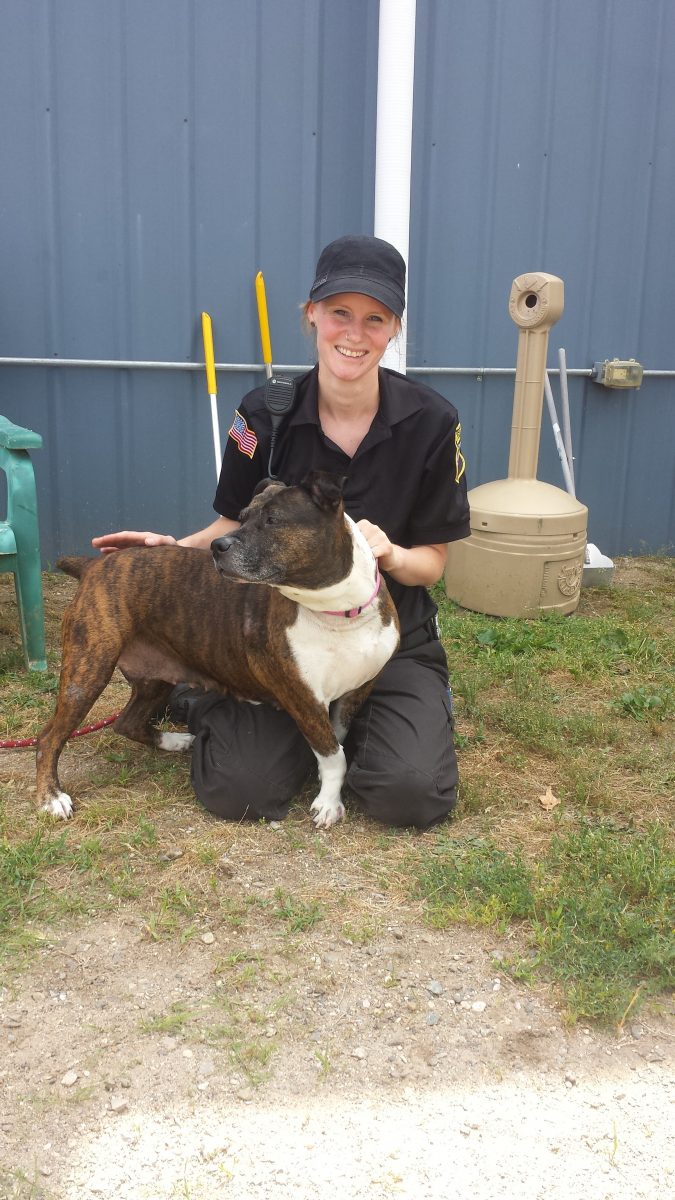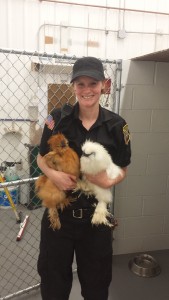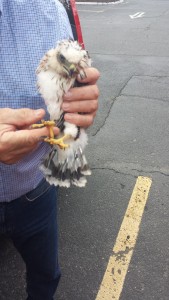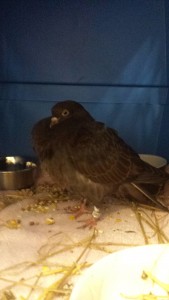WESTFIELD—As animal control officer Margaret Terklesen walks by the Westfield Animal Shelter’s cages, cats meow, dogs bark and a rooster crows. Yes—a rooster.
These are just some of the animals in the care of the Westfield Animal Shelter, where Terklesen assistant manages alongside manager and animal control officer Lori Charette. But many people may not be aware of the services that animal control provides or what they see on a daily basis, which can be just about anything.
“Someone called yesterday saying that they saw a hawk in their backyard and saw no nest,” Terklesen said. “They thought it was hungry so they fed it ground beef.”
Terklesen advised to never feed wild animals, especially food that they wouldn’t come across in nature. Regardless, the hawk was in need of care since it appeared to have fallen out of its nest. The bird had no injuries, but was obviously young, with fluffy white feathers around its neck and wings, which suggested that it wasn’t ready to be out of its nest. So the night before, at 9 p.m., Terklesen had to go and secure the bird from the backyard, and bring the animal the following morning to the local “birdman”—according to his license plate—Tom Ricardi from Conway.
Ricardi and Terklesen met in a local parking lot and exchanged the bird, which Ricardi estimated was just five to six weeks old and said that it is a Cooper’s hawk. While there, Ricardi showed another bird he picked up earlier in the day in Ashfield—a young falcon. These two birds will add to Ricardi’s current number of 65 total at his home in Conway.
For Ricardi and Terklesen this is at least a weekly occurrence. They will meet up and exchange a bird, and Ricardi will nurse it back to health and set it free. And Ricardi said that animal control officers like Terklesen help keep animals safe, as well as helping animal rescuers like Ricardi stay in business.
“Without animal control, forget it,” Ricardi said. “We wouldn’t have many calls without them.”
While Terklesen was waiting for Ricardi to show up, her to-do list had grown. She was meeting Ricardi for 11 a.m., had to bring paperwork to the Westfield Police Department and then she was requested to go to Easthampton as soon as possible to take care of a cat stuck in a tree.
“When cats go up in trees it’s because they’re scared of something,” Terklesen said. “They do eventually come down.”
Within 10 minutes of heading toward Easthampton though, another call came in. Another animal was in a tree in Westfield. But instead of a cat, it’s a bear.
Terklesen said that for bear calls, like cat calls, there isn’t much that animal control can do. So, she will have to go to the area where the bear was seen and just warn people about the sighting and to go inside.
Terklesen said that this is what she finds most frustrating about the job.
“I go home many days feeling like a failure because of the decisions I’ve made and people not understanding,” Terklesen said.
“Animal jobs are hard because you’re dealing with animals and they can’t talk, and it’s almost more people-oriented,” she said. “At the end of the day those in animal care don’t feel like they’ve done enough due diligence.”
Terklesen described what psychologists would call “compassion fatigue,” and it’s a difficult reality for those in animal rescue. Compassion fatigue strikes those who have to care for others often and, among other symptoms, it can cause feelings of depression, hopelessness, anxiety and suicidal thoughts. According to an American Journal of Preventive Medicine study, this also puts animal rescue workers at a rate of on-the-job suicide of 5.3 per 1 million. That’s the same rate as police officers, detectives and firefighters, all of which were the highest in the study.
And the stress that causes compassion fatigue can build up while on the job over time.
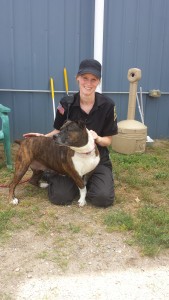
Margaret Terklesen with Bonnie, a pitbull mix at the shelter that is receiving care, originally found in Easthampton.
After Terklesen finished her rounds warning the neighbors about the bear sighting—with an occasional “thank you” thrown in that she greatly appreciated—it was off to Easthampton to deal with the cat in the tree.
Terklesen is greeted by an elderly woman who is clearly concerned for the cat. She thinks that the cat will die if it is not taken down out of the tree—which is about 60 feet up. The cat was meowing constantly, while the potential culprits that scared the cat into the tree are barking from behind a glass door in a neighbor’s house.
Terklesen informed the woman that there was nothing they could do but wait the cat out and put food at the bottom of the tree, but the woman did not seem satisfied. Frustration was growing in both of them, but neither was rude. Still, it’s this type of stress that can wear on someone—the inability to help.
After some discussion though, the woman eventually obliged to Terklesen’s suggestions, and promised to put food out for the cat in an attempt to coax it down. Then Terklesen went around to neighbors’ homes, trying to find out whose cat it was and what to do in the meantime. No one knew the cat or its owners, and one neighbor told Terklesen again that the cat would die up there.
After talking with a couple neighbors and writing a warning to the home of the barking dogs, it was time for Terklesen to head back to the animal control office. She arrived back and the scene was just like it was when she left—cats meowing, dogs barking and a rooster crowing.
Seeing the dogs and cats, Terklesen brightened up. Her voice changed to a higher pitch and the animals seemed to gravitate toward her. Except for one homing pigeon, who tried to punch at her with its wing. This, according to Terklesen, is normal behavior for a pigeon, as well as some other birds.
Even the rooster and its mate, two silky chickens found in a front yard in West Springfield, seemed to appreciate Terklesen. They clucked and cawed and strutted toward her as she opened the gate to show them off, and they allowed her to hold and pet them.
You can see that this is the part Terklesen finds worth it all, and this is the part that draws people into animal rescue work.
“It’s pretty rewarding,” she said. “You have good days and bad days, but it’s nice to adopt dogs and cats out to good families.”
And by how Terklesen looked with the animals around her, they seem to help, too.
Editor’s Note: In an effort to mirror the uniqueness of The Westfield News Radio Show where we meet and speak with interesting people around the area, The Westfield News is embarking on a series of what we’re calling, “a day in the life.” We will periodically spend a few hours with people who have interesting stories or jobs to give you, the readers, a different perspective on life in the greater Westfield area.

